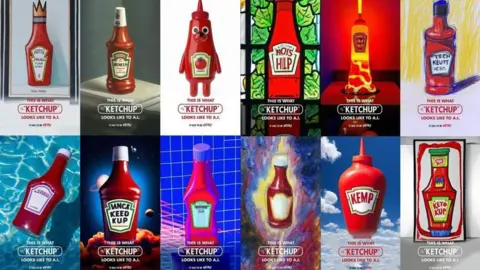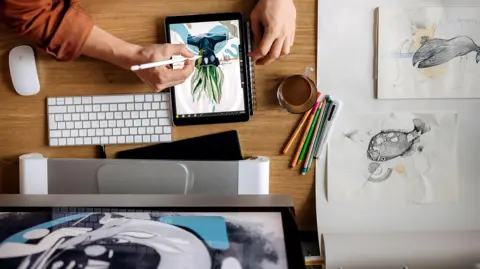Alice CullinaneWest Midlands
 Darby Hutchby
Darby HutchbyWhen Darby Hutchby was studying visual communication at university in 2017, artificial intelligence (AI) was a concept she was only beginning to hear about in its infancy.
Eight years later, employers are able to turn to AI instead of hiring staff, and graphic design graduates like her said they felt they were “competing” against the technology to get a job.
Major companies are already starting to use the technology in their marketing campaigns, which is narrowing the number of vacancies and increasing clients’ expectations for faster work results.
“Because AI can create things so quickly, clients expect designers to do the same, but we take a lot more of a personal approach,” said Ms Hutchby, 27, a Birmingham City University graduate.
In 2022, Heinz generated 12 images of ketchup using the intelligence tool OpenAI for an advert. Coca-Cola created a fully AI-generated ad for Christmas last year featuring the brand’s iconic truck with consumers drinking Coca-Cola Zero Sugar.
Fashion brand Mango came under fire for using AI teen models in their campaign Sunset Dream, as people argued it was taking jobs away from humans and should be considered as “false advertising”.
 Heinz Creative
Heinz CreativeMs Hutchby spent more than a year finding a permanent creative job after graduating from university in 2020, a process which made her question her degree when applications didn’t receive a response.
“I did think, ‘Oh God, what have I done? I’ve just spent all this money and time on a degree, but am I even going to get a chance to use it?’,” she said.
The graduate, who is looking for freelance graphic design work in Birmingham, has decided to upskill in animation so she can stand out to clients, offer a range of services and “bring as many strings to the bow as possible”.
According to the not-for-profit organisation World Economic Forum (WEF), graphic design jobs will be one of the fastest declining roles by 2030 due to the rise in AI.
It is one of many industries affected by the technology, as companies use it to cut down on employees, an example being the buy now, pay later company Klarna.
The company introduced an AI assistant for customer service and said it aimed to get rid of almost half its employees in the coming years due to the technology.
However, in May, the Independent reported that Klarna’s 700 AI job cuts had led to “lower quality customer service” and planned to rehire staff to improve the team.
 Ashleigh Sadler
Ashleigh SadlerAshleigh Sadler graduated from Sheffield Hallam University with a degree in graphic design in the summer. She thinks her university could have prepared students more about the developments of AI and how difficult it would be to find a job after graduating.
“AI is damaging for small businesses, and it is taking opportunities away from designers. It’s worrying when you’re trying to break out in the industry,” she said.
The 21-year-old from Cleethorpes, Lincolnshire, said she was almost tempted to retrain as a paramedic, as the job hunt proved difficult with fewer companies willing to hire staff.
“I’ve put all this effort in, studying for five years for AI to come round now. It made me question the degree and think, ‘What have I been doing all this work for?'”
Now working at a marketing agency company, she said she was “really grateful” to have secured a job, as she knew a lot of people who were struggling to find work.
University of Brighton graduate Grace Warren said she felt like she was “thrown into the deep end” after finishing her course this year and left without much advice on internships and the industry.
“I felt far from fully prepared, and I think the industry has changed so much since lecturers went to uni,” she said.
The 22-year-old from Bath has mixed opinions on AI. She believes it’s an opportunity for graduates to become experts in the technology and use it to their advantage for future careers.
However, she said it was easy to feel pressurised into becoming a “robot” and learning an endless number of skills to fit job descriptions.
“Feeling threatened by AI is a real thing, you are competing against it and it makes you feel extra pressure to do even better,” she said.
 Getty Images
Getty ImagesDr Rebecca Ross from the University of the Arts London said it was a misconception that AI would “kill” the graphic design industry, as designers would adapt and use it in “unexpected ways”.
“Graphic design has always developed in step with technological change – from letterpress to phototypesetting to desktop publishing and now Gen AI,” she said.
Dr Ross said AI could open up new opportunities for designers, but it was “impossible” to fully predict how it would change the industry.
One aspect that is changing is what employers look for in entry-level jobs – while some companies want graduates to help them use AI, others look to hire people with “distinct voices” to stand out against the technology’s “churn”.
“In this sense, the practiced human hand and human eye remain as important as ever,” Dr Rebecca Ross said.
Milk&Tweed, a creative agency based in Wiltshire, said it looked out for someone with a proactive mindset and attitude when hiring staff members.
“I always like to hear people say, ‘This is a project I did for free for my mum’s business’, or ‘My dad’s mate’, as to me that shows that you enjoy it,” founder Jake Jeffries said.
He said that ideas were as important as ever to a portfolio, and having software knowledge like Adobe and gaining real-life experience “off your own back” helped graduates stand out.
Mr Jeffries encouraged people to pay attention to trends, as they were “defining factors” of a project and would help designs to stay remembered.
Disclaimer : This story is auto aggregated by a computer programme and has not been created or edited by DOWNTHENEWS. Publisher: BBC








